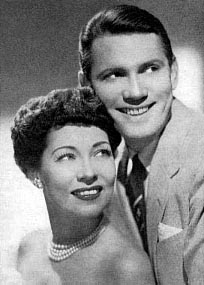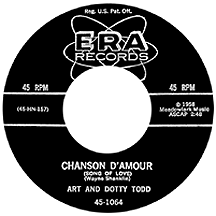ART AND DOTTY TODD
Chanson D'Amour
Like a quadruple-play in baseball (which has happened, though it isn't specifically recognized in the game's rules), there is the rare "double one-hit wonder" (technically not possible, but there is a way around the rule). Art and Dotty Todd are one of the few examples.
Their love affair and career together in music began when both were booked as separate performers at the Providence Biltmore Hotel. There was Art, the guitarist from Baltimore barely in his twenties, and Dotty, the classically-trained pianist from New Jersey not yet out of her teens, a chance meeting in Rhode Island's largest city, followed by wedding bells for the two in 1941. After several years of working the road (including a stretch in the Army during World War II, where Art performed for the troops, of course), all the while hoping to a break into the record industry during the era of the big bands, the Todds eventually wound up in the Los Angeles area with a steady schedule, performing in clubs and lounges in the L.A. area and the Nevada casinos with their traditional act rooted in the musical style of the 1930s and '40s. The hoped-for recording career came with an RCA Victor release in early '53, "Broken Wings," a failed attempt in the U.S. but a top ten hit in England, though a competing version by U.K. group The Stargazers was bigger, hitting number one.
Having a hit in England didn't go unnoticed by booking agents in the States, and the Todds were working constantly from this point on. Five years later Wayne Shanklin approached them with a song he'd written, "Chanson D'Amour (Song of Love)." The husband-and-wife team recorded a demo, and as often happened in the '50s, a record label (Era in this case) grabbed it, released it, and suddenly Art and Dotty's quick take was in hot rotation on stations from coast to coast, a top ten radio hit that fell just short of the top ten in sales in the spring of 1958.
If Art and Dotty Todd were anti-rock and roll and the substantial airplay of "Chanson D'Amour" was a protest of sorts by radio programmers who didn't like the sounds of the burgeoning rock era, there's still a factor they overlooked: the undeniably catchy song fit right in with the '58 music scene. Perhaps if the song had been recorded in a more calculated studio session it would have sounded more traditional and thus less exciting, but the demo was perfect as it was and the people at Era knew that. One listen to the earlier song, so big a hit in England, a genuinely old-fashioned throwback made just five years earlier, and the hipness of "Chanson" becomes strikingly obvious.

Yet deep down, Art and Dotty may not have been buying into music's new direction. I was living in Reno, Nevada in the 1970s and they were constantly popping up at the casinos in those days, performing old standards and "D'Amour" at every show, usually more than once. The musical married couple was well-loved there and in Las Vegas (they performed for many years at the Dunes Hotel), plus who knows how many other cities around the country. In an interview for one of the local Reno papers, they were asked to share their opinions on contemporary music and proceeded to talk about "All I Have to Do is Dream" by The Everly Brothers, The Platters' "Twilight Time," The Chordettes' "Lollipop" and "Wear My Ring Around Your Neck" by Elvis, with Dotty in particular giving this review of David Seville's "The Witch Doctor": "We didn't care much for that one." Only songs from the spring of 1958 were mentioned, the very records "Chanson D'Amour" had been in competition with, suggesting the couple hadn't paid much attention to anything that came after. Nearly two decades had passed, and that was all they had to say about the "new" music!
In 1980 Art and Dotty moved to Honolulu, Hawaii, opened their own club with the proceeds from all those years on the lounge circuit, and spent their remaining years giving Don Ho a run for his money. They continue to be fondly remembered in the U.S. for their one hit. They are also remembered in England for their one hit. It's just two different songs, that's all. A prime example of the double one-hit syndrome!


